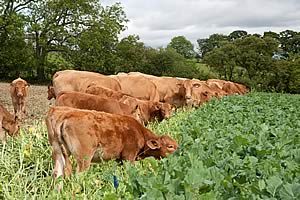2011-05-03
The prospect of another dry summer followed by a further winter of uncomfortably high feed prices makes the most effective management of silage-making particularly important for beef producers across the country this season, stresses EBLEX – the industry body for English beef and lamb levy payers.
Sowing a brassica crop for winter feed helps prevent extra concentrate purchases if there are silage shortfalls.
 |
While quality silage will be especially valuable in minimising winter concentrate purchasing requirements, the experience of last season reinforces the critical need for sufficient feed stocks to last through the winter.
As well as growing the best possible grass crop and ensiling it with the minimum of both field and storage losses, the latest EBLEX BRP Manual – Making Grass Silage for Better Returns – urges producers to keep a careful eye on the adequacy of their forage stocks as the season progresses. This will allow early action to address home-grown forage shortfalls with the greatest possible economy.
The new manual emphasises the extent to which simple assessments of fresh forage stocks can be misleading given that animal requirements depend primarily on dry matter levels.
It provides typical density estimates for a range of grass, maize and whole-crop silages, allowing clamp and big bale dry matter stocks to be calculated quickly and easily. At the same time, it sets out likely dry matter intakes for a range of animal types so winter feeding requirements can be determined and the balance between stocks and requirements effectively monitored as the forage season progresses.
Where potential winter feed shortfalls are identified early enough, EBLEX suggests a number of ways in which they may be addressed without resort to extra concentrate purchases. These include:
- Sowing a brassica crop for winter feeding
- Reducing stock numbers or out-wintering some stock
- Securing additional forage sources like standing maize crops
- Buying-in moist feeds like brewers’ grains
- Buying-in straw for feeding with liquid feeds like pot ale syrup or molasses;
- Buying-in stock feed potatoes or food processing wastes;
- Planting a grass catch crop for early spring grazing
- Reducing waste by better managed silage feeding and
- Ensuring the greatest mixer/feeder wagon weigh scale accuracy.
 Kiotechagil Launches New Enzyme Range - Feedzyme Kiotechagil Launches New Enzyme Range - Feedzyme
 Dangers of Spring Grass - Producers Get a Word of Warning Dangers of Spring Grass - Producers Get a Word of Warning
 The Effect of Reducing Cobalt Levels in Mineral Supplements The Effect of Reducing Cobalt Levels in Mineral Supplements

|




